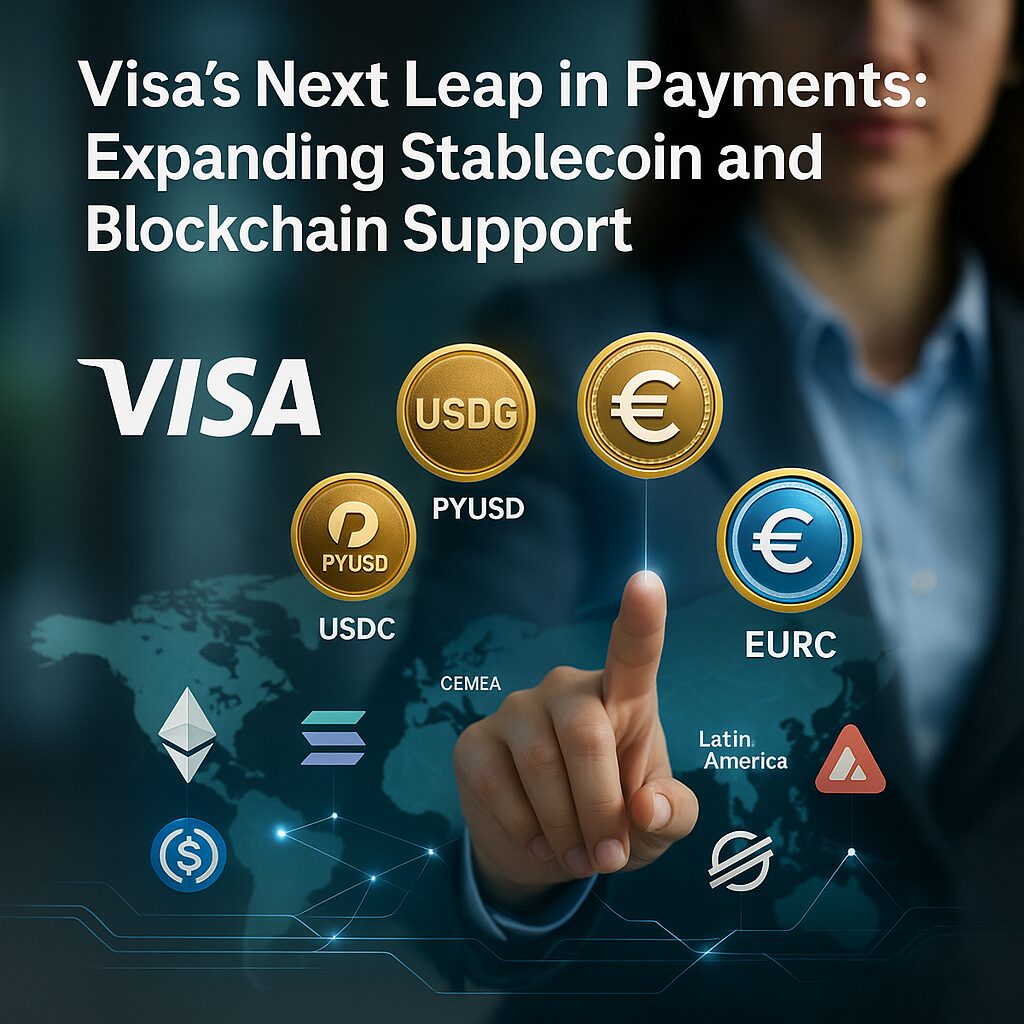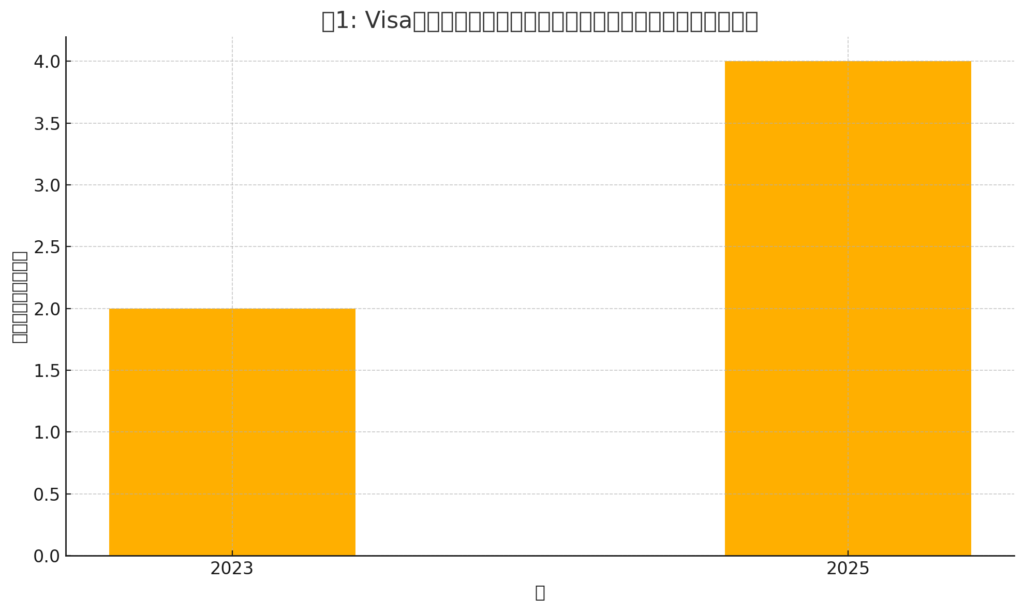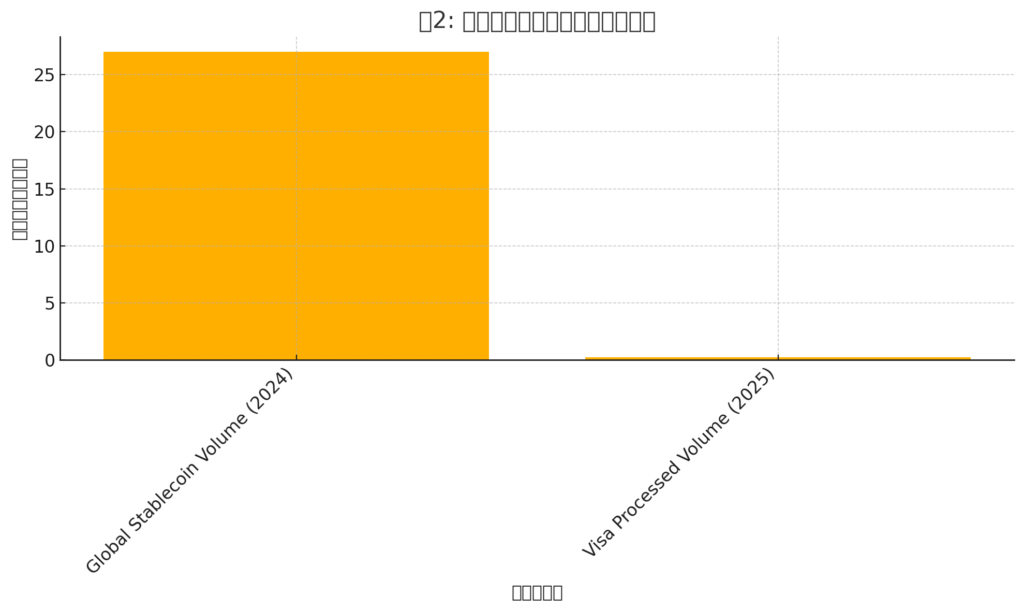
Main Points:
- Visa has added support for two USD-backed stablecoins (Global Dollar USDG & PayPal USD PYUSD) alongside USDC.
- A new euro-backed stablecoin (EURC) is now part of Visa’s settlement platform.
- Blockchain compatibility extends beyond Ethereum and Solana to include Stellar and Avalanche (with Solana still in pilot).
- These enhancements enable faster, cheaper cross-border payments and strengthen partnerships in CEMEA and Latin America.
- Visa is collaborating with Paxos, Circle, Yellow Card, Bridge (Stripe), and BVNK to build interoperable payment rails.
- Global stablecoin transaction volume is projected at $27 trillion in 2024; Visa’s own stablecoin settlements have processed $0.2 billion to date. (See Figures 1 & 2)
- Regulatory clarity and infrastructure investments are critical for pushing stablecoin settlement usage from 10–20% toward 50% within a year.
1. Introduction: A New Era for Programmable Money
In response to surging demand for digital assets and real-time settlement, Visa announced on August 1, 2025, that its global payments network will support two additional dollar-pegged stablecoins—Global Dollar (USDG) and PayPal USD (PYUSD)—in partnership with Paxos, as well as Circle’s euro-pegged EURC. This expansion builds on Visa’s 2023 pilot of USDC on Solana and its earlier Ethereum integration.
2. Adding USDG & PYUSD: Broadening Dollar Settlements
USDG & PYUSD Integration
Through the Paxos partnership, Visa now settles transactions using USDG and PYUSD directly on its platform, enabling merchants and financial institutions to leverage trusted, compliant dollar-backed tokens. This move not only diversifies stablecoin options but also underlines institutional confidence in blockchain-native payments.
3. Introducing EURC: Euro on-Chain
Euro-Backed Settlement
Visa’s integration of Circle’s EURC brings euro-denominated stablecoin settlements into the fold, empowering European partners with seamless on-chain euro transfers and complementing existing dollar rails. Early pilot projects allow select merchants to toggle between dollar and euro payments, optimizing foreign-exchange exposure.
4. Multichain Expansion: Stellar & Avalanche Onboarding
Beyond Ethereum & Solana
While Visa already supports USDC on Ethereum and maintains a rolling pilot on Solana, the platform now fully supports Stellar and Avalanche networks. Stellar’s efficiency in low-value remittances and Avalanche’s rapid finality offer diverse settlement pathways. Solana support remains in trial, with full rollout expected later in 2025.
(Insert Figure 1: Visa Supported Blockchain Networks Over Time)

5. Benefits: Faster, Cheaper Cross-Border Payments
Optimized Settlement
By leveraging multiple chains, merchants can choose rails with the best combination of speed, cost, and liquidity. Visa estimates that stablecoin transfers can settle in minutes to hours, compared to 3–5 business days for traditional wire transfers.
6. Regional Partnerships & Pilot Programs
CEMEA & Latin America Focus
Visa plans to expand stablecoin post-trade processing in CEMEA (Central Eastern Europe, Middle East & Africa) and Latin America. In Africa, Visa is teaming with Yellow Card to offer 24/7 USD-denominated cross-border payments. Meanwhile, collaboration with Bridge (Stripe) aims to issue Visa cards linked directly to stablecoin wallets via a single API.
Infrastructure Build-Out
Investment in BVNK—a global funds-infrastructure provider—furthers Visa’s interoperable rails strategy. BVNK’s platform underpins liquidity management, ensuring stablecoin pools can efficiently settle fiat conversions on demand.
7. Market Outlook & Regulatory Imperatives
Transaction Volume & Uptake
Stablecoins are projected to facilitate approximately 1.25 billion transactions totaling $27 trillion in 2024. To date, Visa’s settlement platform has processed around $0.2 billion of such transactions, highlighting room for growth.
Regulatory Framework
Visa executives emphasize the necessity of clear, consistent regulation for digital-asset payments. They anticipate that, with robust compliance guidelines, the share of stablecoin usage in total settlement could rise from 10–20% today to over 50% within 12 months.
(Insert Figure 2: Stablecoin Transaction Volumes Comparison)

8. Conclusion: Laying the Foundation for Global Digital Commerce
Visa’s expanded stablecoin and blockchain support underscores a strategic commitment to programmable, borderless money. By adding USDG, PYUSD, EURC, and integrating Stellar and Avalanche networks, Visa not only diversifies its settlement toolkit but also accelerates the practical use of blockchain in enterprise payments. As partnerships deepen across regions and regulatory clarity improves, Visa’s approach may well redefine the speed, cost, and accessibility of global commerce.

